1. What Makes It So Good?
There’s just something about creamy mushroom pasta that feels like a small act of self-care. It’s not flashy. It doesn’t rely on rare ingredients or complicated steps. But it always delivers especially when you want something warm and grounding without much fuss.
Part of the magic comes from the mushrooms. They’re earthy, savory, and full of that deep flavor chefs call umami. You don’t need a dozen spices or long simmering times to get complexity a good sauté and a splash of cream (or a clever dairy-free alternative) is often enough.
And then there’s the sauce. Silky. Coating each strand of pasta just enough. The way it clings to a forkful with a bit of garlic, maybe a crack of pepper, is exactly what makes it feel like comfort food at its best.
What makes it even better? You can make it your own. Add spinach. Swap the cream for oat milk. Use gluten-free pasta. Keep it simple or layer in your own flavor twists. It’s the kind of recipe that works whether you’re cooking for guests or just throwing something together for yourself at the end of a long day.
2. Core Ingredients You Can’t Skip
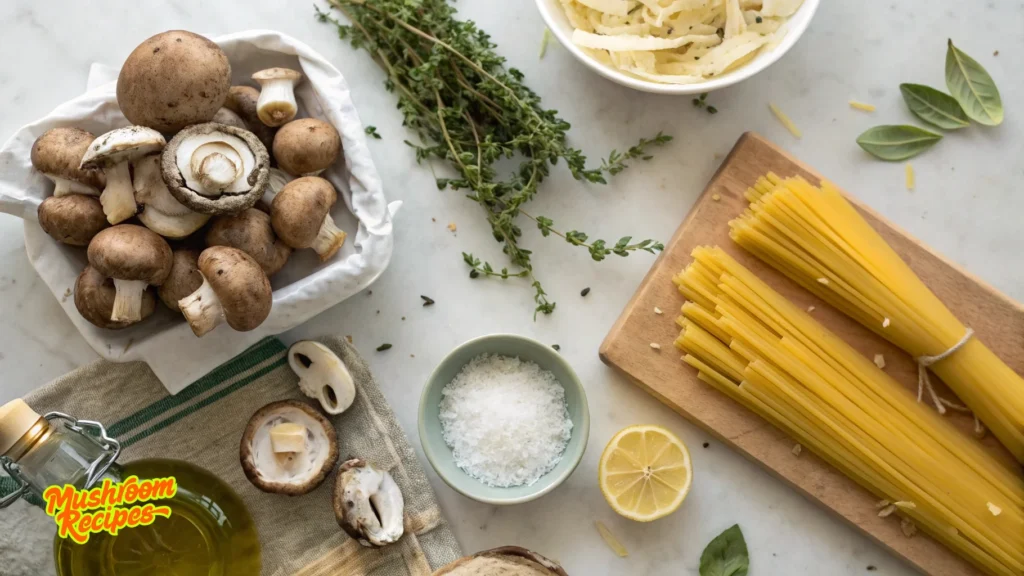
At the heart of every good creamy mushroom pasta is a short list of ingredients that do the heavy lifting. You don’t need much, but the quality and care you give each one can make or break the final dish.
Start with the mushrooms. This isn’t the place to go cheap. Fresh cremini mushrooms are a solid choice if you’re keeping things simple. If you’re feeling a little fancy, mix in some shiitake or oyster mushrooms. They bring a deeper, more interesting flavor. Slice them thick enough so they don’t disappear in the pan, and give them room to brown.
Next comes the pasta. Fettuccine, linguine, rigatoni it doesn’t really matter what shape you use, as long as it holds onto the sauce. Avoid super delicate pasta shapes like angel hair. They tend to get lost in a creamy sauce. And if you’re gluten-free, go for pasta made from brown rice or quinoa blends. They have better structure than most.
The sauce is where things get personal. Traditional recipes call for heavy cream, but there are plenty of worthy alternatives if dairy isn’t your thing. Oat cream is a favorite for its neutral taste and smooth texture. Coconut milk works too, though it adds a bit of sweetness. Even blended silken tofu or puréed cauliflower can do the trick if you’re looking for something lighter.
And don’t forget the little things garlic, fresh herbs, olive oil, salt, and a splash of lemon juice. These are the background singers that round everything out. They may not take center stage, but the dish wouldn’t work without them.
Top dairy-free substitutes for cream sauces
3. How to Make the Classic Version Step-by-Step
This is the kind of recipe that becomes second nature after a couple of tries. It’s not fussy. You don’t need to time things down to the second. But if you follow the rhythm, you’ll end up with something that feels way more impressive than the effort it takes.
Step 1: Sauté the mushrooms.
Get your pan hot. Add a splash of olive oil or butter, then toss in the sliced mushrooms. Give them space. Resist the urge to stir too much. Let them get golden and just a little crisp on the edges. This is where the flavor starts.
Step 2: Add the garlic and herbs.
Once the mushrooms are nicely browned, turn the heat down a bit and stir in chopped garlic. Cook it for about 30 seconds — just until it smells amazing. Then add your herbs. Thyme and parsley are great here. Rosemary too, if you like a stronger note.
Step 3: Pour in your cream.
This is the moment it all comes together. Add your cream or whatever creamy base you’re using. Oat cream, light coconut milk, even a quick cashew blend if you’ve got it ready. Stir it gently and let it simmer for a few minutes. You’ll see it thicken slightly and take on all that mushroom flavor.
Step 4: Cook your pasta.
Meanwhile, boil your pasta in well-salted water. Don’t overcook it. You want a bit of bite so it doesn’t go mushy when it meets the sauce.
Step 5: Bring it all together.
Drain the pasta but save a little cooking water. Toss the pasta right into the pan with the sauce. Add a splash of that pasta water if things feel too thick. Stir to coat everything. Taste. Adjust. Maybe a little more salt. Maybe a squeeze of lemon or a pinch of black pepper.
And that’s it. Five steps. One pan. One pot. A bowl of comfort ready in under 30 minutes.
4. Mushroom Sautéing Mastery
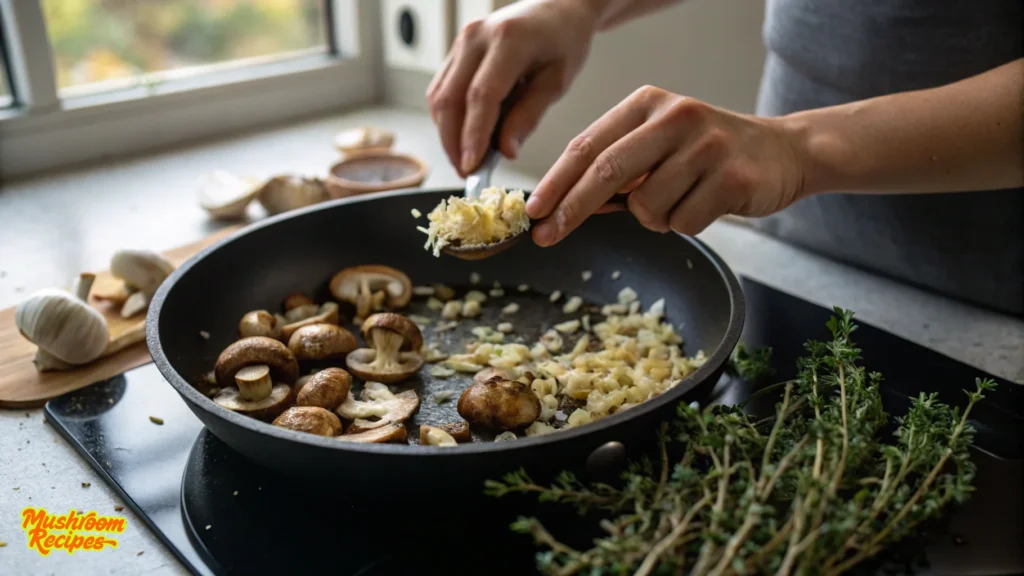
If there’s one step in this entire recipe that you shouldn’t rush, it’s the mushrooms. You can cut corners elsewhere. You can swap out cream for plant-based alternatives. But if your mushrooms don’t hit that sweet spot golden, caramelized, just a little crisp the whole dish falls a little flat.
The good news? Getting it right isn’t hard. It just takes a bit of patience and the willingness to leave them alone in the pan for a minute.
Start With the Right Heat
Mushrooms need high heat. Medium-high, at least. If your pan isn’t hot enough, they’ll release moisture too quickly and start steaming instead of browning. You want that sizzle the second they hit the pan.
Don’t Crowd Them
This is the number one mistake. If the mushrooms are stacked on top of each other, they’ll steam, not sear. Use a large pan. If you’re cooking a big batch, do it in rounds. Yes, it’s a little more effort, but the payoff is big.
Use a Neutral Oil or Butter
Olive oil works, but for more intense flavor, try a bit of butter or even a mix of both. If you’re dairy-free, go with avocado oil or a good-quality plant-based butter.
Let Them Sit
Once they’re in the pan, don’t stir right away. Let them make contact with the heat and develop some color. Flip only when the undersides are golden. This is where the flavor builds in that slow browning.
Season Late
Salt pulls moisture out of mushrooms. If you add it too early, they’ll weep into the pan and start to boil. Wait until they’re mostly browned, then season.
Deglaze If You Want Extra Flavor
When the mushrooms are done, a quick splash of broth, wine alternative, or even a spoonful of your sauce base will lift those browned bits from the pan and pull them into your final dish.
Once you’ve nailed this step, everything else gets easier. The mushrooms carry so much of the flavor, texture, and aroma treat them well, and the pasta basically builds itself around them
5. Vegan and Dairy-Free Alternatives That Don’t Sacrifice Flavor
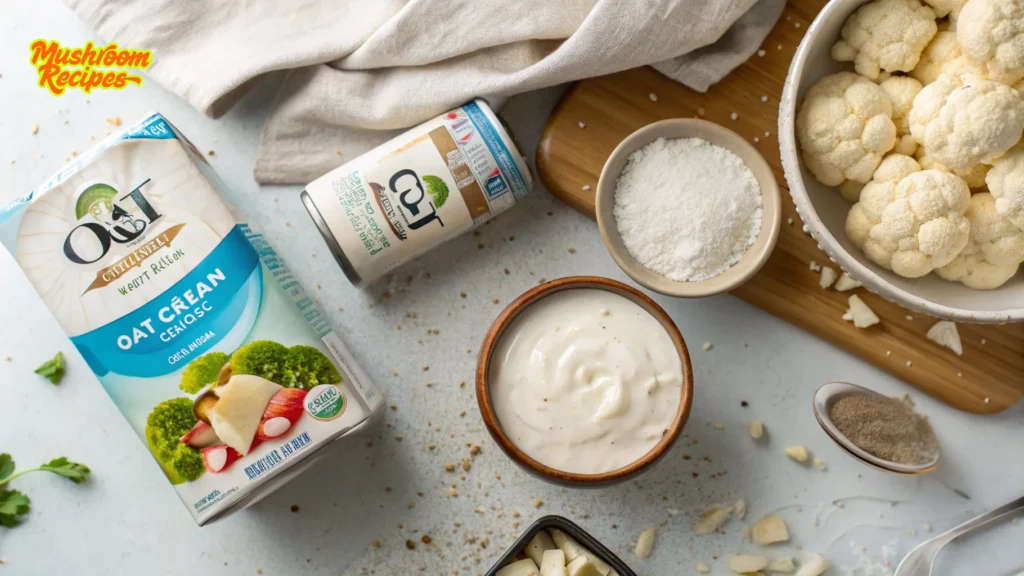
One of the biggest misconceptions about creamy mushroom pasta is that it needs dairy to be good. But the truth is, once you understand how to build richness and depth without cream, you won’t miss a thing.
You don’t need cashews soaked for hours or a high-speed blender that costs more than your rent. The real magic is in how you layer flavor and there are plenty of ways to do it with simple, plant-based ingredients.
“Try this no-cashew vegan version”
Oat Cream
This is probably the easiest swap. It’s thick, neutral in taste, and behaves a lot like dairy cream when heated. No weird aftertaste, no curdling. Just pour and simmer.
Coconut Milk (Light)
A little tropical, a little sweet, but it works surprisingly well especially with garlic and thyme to balance it out. Just go easy if you don’t want that coconut note to take over.
Silken Tofu
This one’s for the meal-preppers and plant-protein fans. Blend it with a little garlic, lemon juice, and salt and you’ve got a silky base with a nice body to it. Works really well when you want a thicker sauce without adding fat.
Cauliflower Purée
Steam it, blend it, season it. That’s it. It makes a light, clean-tasting sauce that still feels creamy perfect if you’re keeping things low-fat or want a more veggie-forward version.
Building the Flavor Without Dairy
Here’s where it really comes together. Use nutritional yeast to add a cheesy vibe. Add a splash of lemon juice to cut richness. Finish with fresh herbs for brightness. And don’t be afraid to taste as you go. Creamy sauces need seasoning more than you think.
The best part? These alternatives don’t just work they’re often lighter, faster, and easier to digest. Once you’ve made it this way a few times, you might not go back.
6. Regional and Gourmet Twists on the Classic Recipe
Once you’ve nailed the base version of creamy mushroom pasta, it’s easy to start playing with it. That’s part of what makes this dish so appealing it’s a blank canvas. A few tweaks here and there, and suddenly it shifts from weeknight comfort food to something you could serve at a dinner party.
Let’s take a look at a few ways people are giving this classic some personality.
Italian-Style
Keep it simple, but make it authentic. Use porcini mushrooms if you can find them. They’re rich, earthy, and deeply aromatic. Pair them with fresh tagliatelle or pappardelle and finish with a little grated Pecorino Romano. A drizzle of good olive oil right before serving doesn’t hurt either.
French-Inspired
Think buttery, herb-forward, and a little more indulgent. Sauté shallots along with your mushrooms, add a touch of Dijon mustard to your cream base, and toss in some fresh tarragon or thyme. It’s a subtle shift, but it gives the dish a refined, brasserie feel.
Plant-Based Gourmet
You can still go upscale without dairy. Try a blend of wild mushrooms maitake, oyster, chanterelles and use oat cream as your base. Add a spoon of white miso or a touch of truffle oil at the end for a deeper umami kick. Serve over a bed of fresh spinach or even polenta for something a little unexpected.
Add-ins That Elevate Without Overcomplicating
Sometimes it’s the smallest additions that change everything.
- Roasted garlic: Sweet and mellow
- Chili flakes: Just enough heat to wake it up
- Lemon zest: A clean, fresh finish
- Toasted walnuts: Adds crunch and richness
7. One-Pot and 30-Minute Variations for Busy Nights
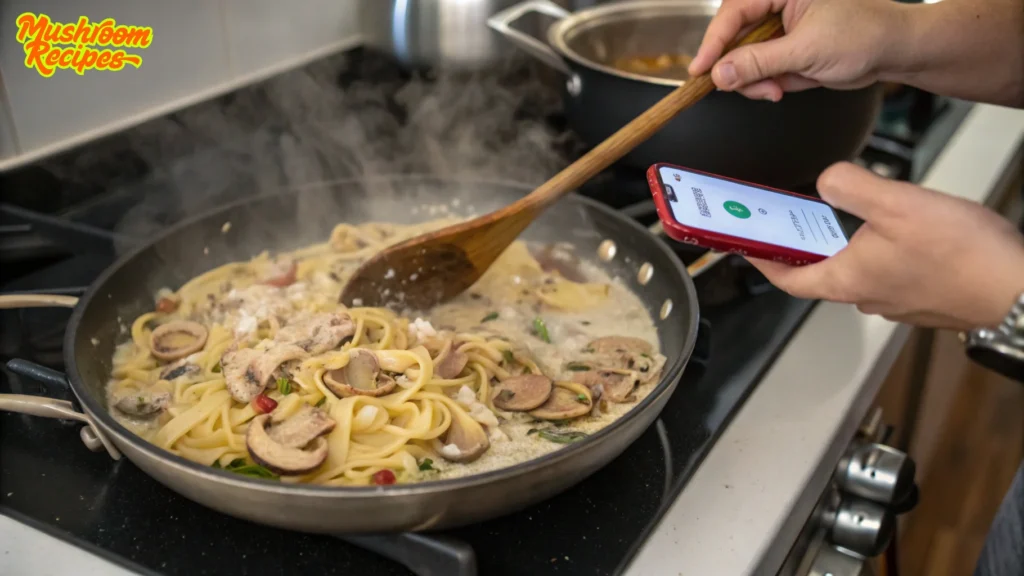
Let’s be real. Some nights, you just want dinner to get itself on the table. No piles of pans. No hour-long prep. Just something warm and filling that tastes like it took more effort than it did.
That’s where the one-pot and quick-cook versions of creamy mushroom pasta come in. They may not be traditional, but they absolutely get the job done and still feel like a proper meal.
The One-Pot Wonder
This method is kind of brilliant. You cook the pasta right in the same pan as the mushrooms and sauce. It means fewer dishes and, bonus, the starch from the pasta helps thicken the sauce naturally. Here’s how it goes:
- Sauté your mushrooms until browned don’t rush it.
- Add garlic, then pour in your broth and cream (or plant-based alt).
- Toss in dry pasta yes, straight from the box and simmer.
- Stir occasionally. Add a bit more liquid if needed.
- When the pasta is tender and the sauce is glossy, you’re done.
It’s comforting, cozy, and maybe the easiest path to creamy mushroom goodness.
30-Minute Meal, No Compromises
Even if you go the traditional route with boiling the pasta separately, you’re still looking at a dish that comes together fast. The secret is in the prep:
- Use pre-sliced mushrooms to skip a step.
- Oat cream or coconut milk goes straight from carton to pan.
- Choose quick-cooking pasta shapes like rotini or penne.
You can get from cutting board to plate in about 25 minutes if you move with purpose maybe even faster if you’ve done this before.
Make-Ahead Shortcuts
Want to move even faster?
- Pre-sauté mushrooms and store them in the fridge.
- Use leftover pasta and toss it in the sauce just to reheat.
- Keep oat cream or non-dairy options on hand in the pantry or fridge.
8. Best Salads and Sides to Serve with Creamy Mushroom Pasta
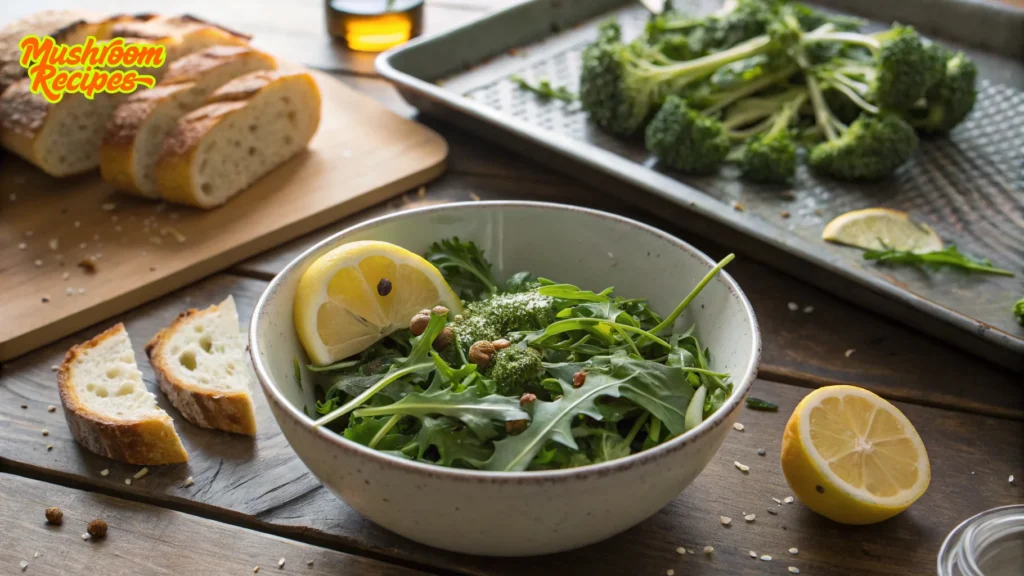
Creamy mushroom pasta is rich. No surprise there. It’s silky, savory, full of depth but it’s also heavy. And that’s why the right side dish isn’t just a bonus. It’s balance.
You don’t need a complicated spread. Just something fresh or bright or crunchy to lighten the whole plate. Here are a few go-tos that do the job without stealing the show.
Arugula Salad with Lemon
This one’s a classic for a reason. Peppery arugula, a squeeze of lemon, maybe a drizzle of olive oil. Done. The sharpness cuts through the cream and keeps your palate from feeling bogged down. Add shaved Parmesan if you’re not dairy-free. Or some thin red onion slices for extra bite.
Roasted Broccoli with Chili Flakes
Toss it in oil, sprinkle with salt, hit it with chili flakes, roast until the edges crisp up. That’s all. The bitterness of broccoli balances the pasta’s richness, and the bit of heat wakes up the dish without overpowering it.
Sourdough or Garlic Bread (Let’s Be Honest, You Were Gonna Do This Anyway)
Soft on the inside, crusty outside and perfect for swiping the last bit of sauce from the bowl. Toast it up with olive oil and a fresh garlic rub if you’ve got time. If not, store-bought works too. No judgment.
Something Green and Steamed
Feeling clean? Steamed green beans or asparagus with a touch of lemon and sea salt will bring freshness without a lot of prep. They don’t fight for attention, but they do reset your taste buds between bites.
Round It Out Without Overdoing It
You don’t need a three-course meal. Just one simple side and a small salad makes the pasta feel intentional like you planned a meal, not just a bowl of carbs.
Best sides that balance out creamy pasta
9. Common Mistakes to Avoid
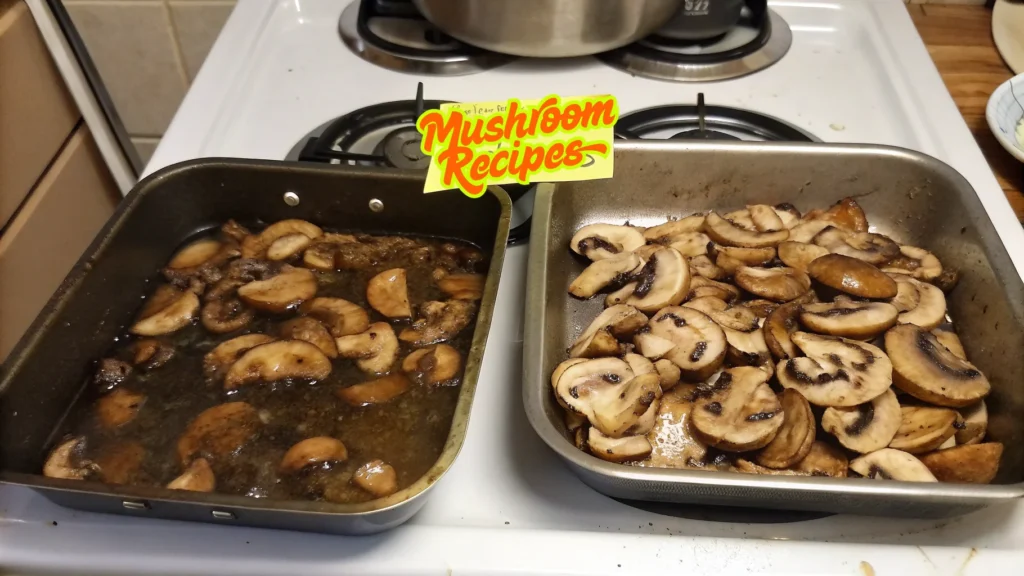
Even with a dish as simple and forgiving as creamy mushroom pasta, a few small missteps can make a big difference. Not enough to ruin dinner but enough to leave you thinking, “Eh… it was okay.”
Here’s how to dodge the most common slip-ups, and what to do instead.
Salting Mushrooms Too Early
It’s tempting. You throw the mushrooms in the pan and reach for the salt. But if you do it too soon, they’ll dump all their moisture and steam instead of brown. That means soggy texture and less flavor.
What to do instead: Wait until they’ve got some color. Salt once the mushrooms are golden and starting to shrink. You’ll keep their structure and boost the caramelized taste.
Using Sweetened Plant Milks
Not all non-dairy milks are created equal. One wrong carton of vanilla-flavored almond milk and you’ve got dessert pasta. Always read the label.
What to do instead: Stick with unsweetened, unflavored oat, soy, or almond milk. Or better yet, grab oat cream — it was made for this.
Overcooking the Pasta
It’s an easy one to overlook. You’re multitasking, the sauce is coming together, and next thing you know, the pasta’s too soft. When it hits the warm sauce, it gets even mushier.
What to do instead: Cook your pasta just shy of al dente. It’ll finish cooking as you toss it in the pan with the sauce — and hold its bite.
Skipping Acid
If your sauce tastes flat or overly heavy, you probably forgot acid. A squeeze of lemon or a splash of vinegar might not seem like much, but it brightens everything up.
What to do instead: Always taste before serving. If it feels dull, add a hit of acid and a pinch of salt. It’s a game changer.
Not Saving Pasta Water
You’ve probably seen it in every pasta recipe by now — and there’s a reason for that. The starchy water helps your sauce cling to the pasta and keeps it from drying out.
What to do instead: Just scoop out half a cup of pasta water before draining. You might not need it, but you’ll be glad you have it.
10. Final Thoughts + Recipe Resources
Creamy mushroom pasta isn’t complicated. That’s kind of the point. It’s the kind of meal that feels cozy and indulgent, but never fussy. What makes it really shine is how adaptable it is whether you’re leaning into the comfort of heavy cream or exploring vegan and dairy-free alternatives that still deliver full flavor, the dish never loses its heart.
Once you’ve got the basics down like how to properly sauté mushrooms to bring out their deep, savory character, and knowing when to salt them so they brown instead of steam everything else falls into place. The rest is just about layering flavors and choosing the right components.
Maybe you’re looking for a version that’s quick enough for a weeknight. A one-pot variation with oat cream can be on the table in under 30 minutes, no extra dishes required. Or maybe you’ve got guests coming over and you want to elevate things a little. Try mixing wild mushrooms, or adding a splash of miso for depth we’ve got a whole section on gourmet and regional twists if you’re ready to experiment.
And don’t forget the plate needs balance. Rich pasta like this benefits from a crisp green side. Our guide to simple salads and roasted vegetable sides can help you put together a full meal without much extra effort.
If you’re working around food restrictions, we’ve also laid out smart, flavor-forward substitutions for pasta, mushrooms, and even cheese that don’t feel like sacrifices. The idea is to work with what you have and what you like not just stick to a script.